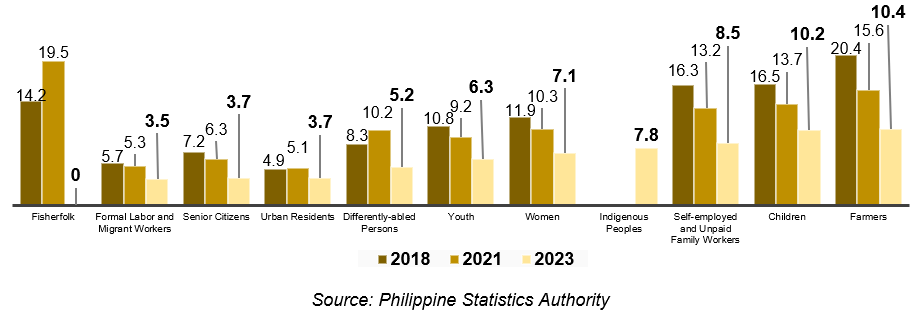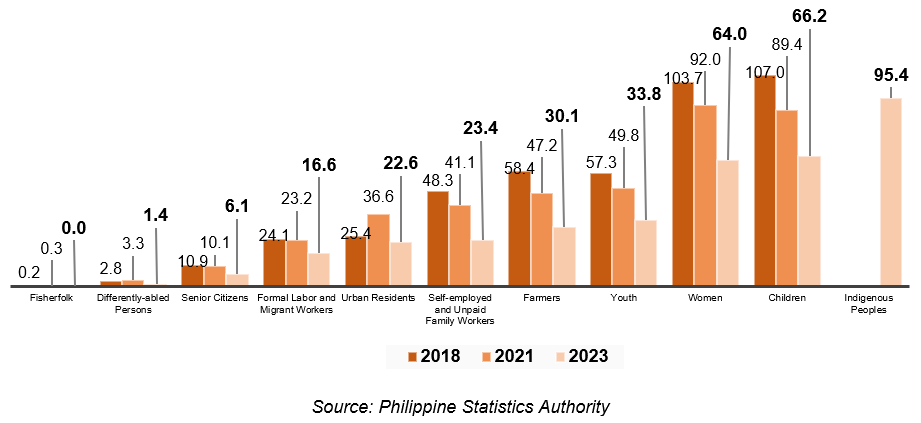The Philippine Statistics Authority (PSA) releases the 2023 Poverty Statistics for the eleven (11) of the fourteen (14) basic sectors identified in Republic Act No. 8425 or the Social Reform and Poverty Alleviation Act. These are the disadvantaged or marginalized sectors of the Philippine society as defined by RA No. 8425, to wit: 1) Farmer-peasant; 2) Artisanal fisherfolk; 3) Workers in the formal sector and migrant workers; 4) Workers in the informal sector; 5) Indigenous Peoples and cultural communities; 6) Women; 7) Differently-abled persons; 8) Senior citizens; 9) Victims of calamities and disasters; 10) Youth and students; 11) Children; 12) Urban poor; 13) Cooperatives; and 14) Non-government organization.
In 2023, new in the list of basic sectors with estimates of poverty incidence is the Indigenous Peoples.
Poverty among basic sectors in the Philippines declines
At the national level, a comparison of poverty incidences among the basic sectors from 2021 to 2023 manifested a decline in all sectors. The sectors that had the highest percentages of individuals belonging to families living below the official poverty threshold were Indigenous Peoples (32.4 percent), fisherfolks (27.4 percent), and farmers (27.0 percent).
On the other hand, senior citizens, formal labor and migrant workers, and individuals residing in urban residents posted the lowest poverty incidences at 7.8 percent, 8.3 percent, and 10.3 percent, respectively.
In terms of magnitude, the sectors with the highest number of individuals belonging to poor families in 2023 were children with 9.3 million poor children, followed by women with 8.7 million, and urban residents with 6.3 million. Meanwhile, the sectors with the lowest number of individuals belonging to poor families were differently-abled persons with 233 thousand, fisherfolks with 353 thousands, and senior citizens with 837 thousand individuals (Table 1).
Table 1. Poverty Incidence and Magnitude of Poor among the Basic Sectors,
Philippines: 2021 and 2023

Poverty in all basic sectors in CAR decreases
In CAR, consistent with the national trend, poverty incidence among all basic sectors declined in 2023 compared to 2021.
Figure 1. Poverty Incidence among the Basic Sectors (in percent),
Cordillera Administrative Region (CAR): 2018, 2021, and 2023

The basic sectors with the highest poverty incidences in CAR were the farmers (10.4 percent), children (10.2 percent), and self-employed and unpaid family workers (8.5 percent). These sectors exhibited a downward trend from 2018 to 2023. Similar improvements were observed among formal labor and migrant workers, senior citizens, youth, and women.
Remarkably, poverty incidence among fisherfolk fell from 19.5 percent in 2021 to zero in 2023. Additionally, formal labor and migrant workers (3.5 percent), and senior citizens (3.7 percent) registered the lowest poverty incidences among the basic sectors (Figure 1).
In 2023, Cordillera was the only region to report zero poverty incidence among fisherfolk. Furthermore, CAR ranked second – next only to the National Capital region (NCR) – in having the lowest poverty incidence across across several basic sectors: a) Formal Labor and Migrant Workers at 3.5 percent; b) Differently-abled Persons at 3.7 percent; c) Youth at 6.3 percent; d) Women at 7.1 percent; and, e) Children at 10.2 percent.
Most poor families in CAR are Indigenous Peoples
In terms of magnitude, the sectors with the highest number of individuals belonging to poor families in CAR in 2023 were Indigenous Peoples (95.4 thousand), children (66.2 thousand), and women (64 thousand poor individuals).
Figure 2. Magnitude of Poor Individuals among the Basic Sectors
(in thousands), CAR: 2018, 2021, and 2023

On the other hand, the lowest numbers were observed among differently-abled persons (1.4 thousand), senior citizens (6.1 thousand), and formal labor and migrant workers (16.6 thousand).
From 2018 to 2023, the populations of poor individuals in several sectors – including children, women, youth, farmers, self-employed and unpaid family workers, formal labor and migrant workers, and senior citizens – showed a decreasing trend.
More poor families found in rural areas
In support to the data requirements of the Sustainable Development Goals (SDGs), particularly those aimed at eradicating poverty across all dimensions and reducing inequalities, poverty statistics for individuals residing in rural areas were added. Accordingly, in addition to the eleven (11) basic sectors, the PSA generated corresponding data for rural residents (Table 2).
Table 2. Poverty Incidence and Magnitude of Poor among Individuals Residing in Urban and Rural Areas, CAR: 2018, 2021, and 2023

In 2023, the poverty incidence among individuals residing in rural areas was recorded at 8.7 percent, marking a decline of 3.5 percentage points from the 13.5 percent registered in 2021. Despite this improvement, poverty incidence in rural areas remained higher than that of urban areas, which stood at 3.7 percent.
Among regions outside NCR, CAR posted the lowest rural poverty incidence at 8.7 percent, followed closely by Region IV-A (CALABARZON) at 8.8 percent, and Region III (Central Luzon) at 10.1 percent.
The total number of poor individuals residing in rural areas in 2023 was estimated at 108 thousands, showing a notable reduction of 40 thousand from the 148 thousand reported in 2021 (Table 2).
(SGD)
ALDRIN FEDERICO R. BAHIT, JR.
(Chief Statistical Specialist)
Officer-In-Charge
Special Order No: 2025ORDCAR-212
Designation Initials Date
CSS AFRBJ 28 July 2025
SSS WBM 18 June 2025
SrSS BYM 16 June 2025
Technical Notes
The estimation of the poverty statistics among the basic sectors was spearheaded by the former National Statistical Coordination Board (NSCB), now part of the Philippine Statistics Authority (PSA), through a project with funding assistance from the United Nations Development Programme and in collaboration with the National Anti-Poverty Commission in 2004-2005. This initiative was in response to the demands for generating lower-level and sectoral poverty statistics.
Estimates disaggregated at the national and regional levels were generated based on the methodology approved per PSA Board Resolution No. 1, series of 2017-132, otherwise known as Approving the Methodology for the Generation of Poverty Statistics for the Basic Sectors.
Per Republic Act No. 8425 or the Social Reform and Poverty Alleviation Act, “poor” refers to the individuals and families whose income fall below the poverty threshold and/or cannot afford in a sustained manner to provided their minimum basic needs of food, health, education, housing, and other essential amenities of life as defined by the Department of Economy, Planning, and Development (DEPDev), former National Economic and Development Authority (NEDA).
Eleven (11) out of the 14 basic sectors as indicated in RA No. 8425 have sectoral and income data from the merged files of the Family Income and Expenditure Survey (FIES) and January round of the Labor Force Survey (LFS), which are the data sources for the computation of poverty statistics among basic sectors. Poverty statistics for persons with disability were generated for the first time in 2018, given the adoption of larger sample size from the 2013 Master Sample and the inclusion of the disability identifiers using Washington Group Short Set on Functioning (WG-SS) based from WG website in the January round of the LFS.
Basic sectors are not mutually exclusive, i.e., there are overlaps among the sectors, which means an individual can belong to two or more sectors (e.g., women and children, women and senior citizens, etc.).
Below are the operational definitions of each sector that were considered:
1. Women – an individual whose declared sex is female;
2. Children – individuals below 18 years old;
3. Youth – individuals 15 years to 30 years old;
4. Senior Citizens – individuals 60 years old and above;
5. Urban Poor – an individual residing in an urban area who belongs to a poor family or whose per capita income falls below the official poverty threshold;
6. Rural Poor – an individual residing in a rural area who belongs to a family categorized as poor or with per capita income falling below the official poverty threshold;
7. Formal Labor and Migrant Workers:
a) Formal sector workers are employed persons working for private establishments and government organizations and corporations
b) Migrant workers are individuals who are overseas contract workers (OCWs);
8. Farmers – employed individuals 15 years old and over whose primary occupation is farming and plant growing or animal production.
9. Fisherfolk – employed individuals 15 years old and over whose primary occupation is fishing;
10. Self-employed and Unpaid Family Workers – employed individuals 15 years and over who are either self-employed or worked without pay on family-owned business;
11. Differently-abled Persons – individuals aged 15 years and above who experienced a lot of difficulty or who cannot do at all any of the following:
a. Seeing even if wearing eye-glasses;
b. Hearing even if using hearing aid;
c. Walking or climbing steps;
d. Remembering or concentrating;
e. Self-care; and,
f. Communicating
12. Indigenous Peoples – based on RA No. 8371, Indigenous Cultural Communities/ Indigenous Peoples (IPs) refer to a group of people or homogenous societies identified by self-ascription and ascription by others, who have continuously lived as organized community on communally bounded and defined territory, and who have, under claims of ownership since time immemorial, occupied, possessed and utilized such territories, sharing common bonds of language, customs, traditions and other distinctive cultural traits, or who have, through resistance to political, social and cultural inroads of colonization, non-indigenous religions and cultures, became historically differentiated from the majority of Filipinos.
Family - a group of persons usually living together and composed of the head and other persons related to the head by blood, marriage or adoption. It includes both the nuclear and extended family.
Poverty incidence (PI) - the proportion of families/individuals with per capita income/expenditure less than the per capita poverty threshold to the total number of families/individuals.

